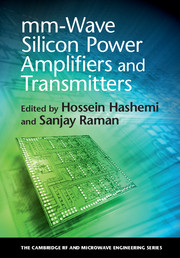Book contents
- Frontmatter
- Contents
- List of Contributors
- Preface
- 1 Introduction
- 2 Characteristics, performance, modeling, and reliability of SiGe HBT technologies for mm-wave power amplifiers
- 3 Characteristics, performance, modeling, and reliability of CMOS technologies for mm-wave power amplifiers
- 4 Linear-mode mm-wave silicon power amplifiers
- 5 Switch-mode mm-wave silicon power amplifiers
- 6 Stacked-transistor mm-wave power amplifiers
- 7 On-chip power-combining techniques for mm-wave silicon power amplifiers
- 8 Outphasing mm-wave silicon transmitters
- 9 Digital mm-wave silicon transmitters
- 10 System-on-a-chip mm-wave silicon transmitters
- 11 Self-healing for silicon-based mm-wave power amplifiers
- Index
- References
4 - Linear-mode mm-wave silicon power amplifiers
Published online by Cambridge University Press: 05 April 2016
- Frontmatter
- Contents
- List of Contributors
- Preface
- 1 Introduction
- 2 Characteristics, performance, modeling, and reliability of SiGe HBT technologies for mm-wave power amplifiers
- 3 Characteristics, performance, modeling, and reliability of CMOS technologies for mm-wave power amplifiers
- 4 Linear-mode mm-wave silicon power amplifiers
- 5 Switch-mode mm-wave silicon power amplifiers
- 6 Stacked-transistor mm-wave power amplifiers
- 7 On-chip power-combining techniques for mm-wave silicon power amplifiers
- 8 Outphasing mm-wave silicon transmitters
- 9 Digital mm-wave silicon transmitters
- 10 System-on-a-chip mm-wave silicon transmitters
- 11 Self-healing for silicon-based mm-wave power amplifiers
- Index
- References
Summary
Why linear?
Two fundamental questions arise in the design of a power amplifier circuit. First, what is the maximum output power given a device technology? Second, what is the peak power-added efficiency (PAE) given a device technology? In this chapter, these fundamental limits on output power and efficiency are analyzed for single-stage, linear millimeter-wave (mm-wave) PAs based on device and circuit factors. Linear amplifiers are favored under several conditions. Foremost, a linear response might be demanded for complex signaling. Quadrature amplitude modulation (QAM) requires a linear response to support the peak-to-average power ratio (PAPR) of the signal envelope. As shown in Fig. 4.1, the in-phase and quadrature symbols – shown as a 64QAM constellation – are up-converted to an RF carrier and amplified by the power amplifier. The envelope of the modulated RF signal is shown at the output of the PA and demonstrates substantial variation in the output power. The ratio of the peak-to-average power indicates the linearity requirements of the power amplifier. Additionally, concerns about the out-of-channel interference, e.g. spectral leakage, also dictate requirements for system linearity. However, specification of adjacent channel interference is not well-established at mm-wave bands since the spatial selectivity of the communication system at these bands is considered to be higher than for RF systems.
In RF systems, linear amplifiers are rarely sufficiently linear and additional linearization can be introduced in the form of feedforward, feedback, or digital pre-distortion. The evolution of communication standards tends to favor more spectrally efficient communication and, in turn, motivates interest in linearization techniques for power amplifiers. In the case of mm-wave communication, early commercial standards have avoided the need for linear amplifiers by using constant envelope waveforms such as GMSK or simple modulation schemes that feature low PAPR such as QPSK. As more interest develops in mm-wave QAM, circuit and system techniques that offer a linear variation in the output power will return to the forefront.
A second motivation for linear amplifier designs is that this class of operation may offer competitive output power and efficiency at mm-wave bands to other classes of amplifiers. For instance, switching amplifiers require harmonic control that complicates the design of these amplifiers over wide bandwidth at mm-wave bands. Another desirable feature of linear amplifiers is that two PAs can be configured to be maximally efficient at both the average and peak power levels.
Information
- Type
- Chapter
- Information
- mm-Wave Silicon Power Amplifiers and Transmitters , pp. 139 - 179Publisher: Cambridge University PressPrint publication year: 2016
References
Accessibility standard: Unknown
Why this information is here
This section outlines the accessibility features of this content - including support for screen readers, full keyboard navigation and high-contrast display options. This may not be relevant for you.Accessibility Information
- 1
- Cited by
